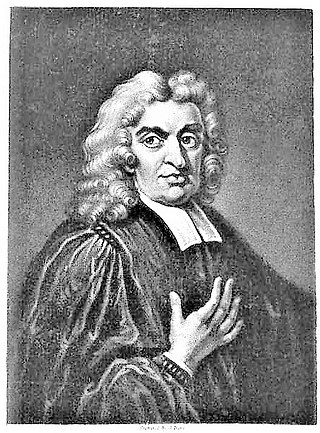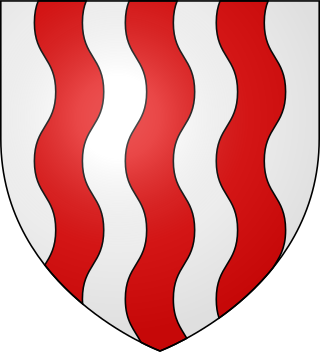Related Research Articles
Hugh Bigod, 1st Earl of Norfolk (1095–1177) was the second son of Roger Bigod, sheriff of Norfolk and royal advisor, and Adeliza, daughter of Robert de Todeni.

Rev. Francis Blomefield, FSA, Rector of Fersfield in Norfolk, was an English antiquarian who wrote a county history of Norfolk: An Essay Towards a Topographical History of the County of Norfolk. It includes detailed accounts of the City of Norwich, the Borough of Thetford and all parishes in the southernmost Hundreds of Norfolk, but he died before completing it. This was done by a friend, Rev. Charles Parkin. The Norfolk historian Walter Rye related that although no portrait of him was known to exist, Blomefield closely resembled the astronomer John Flamsteed, whose portrait was used to depict Blomefield on the frontispiece of one of his volumes. His history of Norfolk was reissued in London in 11 volumes by William Miller in 1805–1810, the last seven being by Parkin.

Ralph de Gaël was the Earl of East Anglia and Lord of Gaël and Montfort. He was the leading figure in the Revolt of the Earls, the last serious revolt against William the Conqueror.

Sisland, historically Sislanda, is a very small village, manor and parish in the county of Norfolk, England, about a mile west of Loddon. In the 2001 census, the population was 44 in 16 households. The parish covers an area of 1.90 km2 (0.73 sq mi), and is approximately 9.3 miles (15.0 km) southeast of Norwich and 12.7 miles (20.4 km) west of Great Yarmouth. For the purposes of local government, it falls within the district of South Norfolk, however Sisland does have its own Parish Council. The village contains only one heritage-listed building, that being St Mary's Church, which is Grade II*.
Sir William Boleyn, KB of Blickling Hall in Norfolk and Hever Castle in Kent, was a wealthy and powerful landowner who served as Sheriff of Kent in 1489 and as Sheriff of Norfolk and Suffolk in 1500. He was the father of Thomas Boleyn, 1st Earl of Wiltshire, whose daughter was Queen Anne Boleyn, the second wife of King Henry VIII.
Sir Roger Townshend KS was an English landowner, judge, and politician. Though his ancestors had held lands in Norfolk for generations, their estates being centred on the village of Raynham, he was the first of his family to attain national prominence.

Pentney is a village and civil parish in the English county of Norfolk, located about 8 miles (13 km) south east of King's Lynn placing it about halfway between King's Lynn and Swaffham on the A47 road. It covers an area of 10.39 km2 (4.01 sq mi) and had a population of 387 in 184 households at the 2001 census, increasing to 544 at the 2011 Census. For the purposes of local government, it falls within the district of King's Lynn and West Norfolk. It is in the valley of the River Nar, a tributary of the River Great Ouse.

Pentney Priory was an Augustinian priory at Pentney in the district of King's Lynn and West Norfolk, Norfolk, England. The ruins of the priory, mostly comprising the flint-built gatehouse, are Grade I listed.

Flixton Priory was a nunnery under a prioress following the Augustinian rule, which formerly stood in the parish of Flixton in the north of the English county of Suffolk, about 3 miles (4.8 km) south-west of Bungay. It was founded by Margery de Creke in 1258, and was dissolved in 1536–37. It was the poorest of the nunneries within the Diocese of Norwich. The site of the priory, which was enclosed by a moat, was at the present Abbey Farm, where little apart from the position in the landscape and a small section of standing wall remain to be seen. It was scheduled as an ancient monument in 1953. It is privately owned and is not open to the public. It is suggested that some parts of the masonry may have been re-used in St Peter's Hall at St Peter, South Elmham.

St Mary's Church is a redundant Anglican round-tower church near the village of Moulton St Mary, Norfolk, England. It is recorded in the National Heritage List for England as a designated Grade I listed building, and is under the care of the Churches Conservation Trust. It stands some 4 kilometres (2 mi) to the south of Acle in an isolated position adjacent to a farm.
Thomas Fowle was a Church of England clergyman, Fellow of St John's College, Cambridge, rector of Redgrave and Hinderclay, Suffolk, and prebendary of Norwich Cathedral.
Lieutenant Admiral Sir William Woodhouse was an English naval commander and administrator who rose to the rank of Lieutenant of the Admiralty and was head of the Council of the Marine later called the Navy Board. He also served as a Member of Parliament of the Parliament of England from 1545 to 1564. He was prominent during an important time of the Navy Royal's development in the later half of the Tudor period.
Robert Rugge, of Norwich, Norfolk, was an English politician. He was a Member of Parliament (MP) for Norwich in 1545 and mayor of the city in 1545-46 and 1550-51.
Roger Devereux was a Norman nobleman who, following the Norman Conquest of 1066, was recorded as holding lands in Norfolk at the time of the Domesday survey of 1086.
Richard Southwell was a 15th-century British administrator from Norfolk. He was a Marshal of the Exchequer and an administrator for the Duke of Norfolk.
Sir Nevill Catlin (1634–1702) of Kirby Cane in Norfolk and of Wingfield Castle in Suffolk, England, was a landowner and member of Parliament from a Norfolk family long active in local and national affairs.

de Valognes is a family name of two distinct powerful families with notable descendants in the centuries immediately following the Norman Conquest. Although a connection between them has been inferred by some authorities, this is not supported by positive evidence.
Sir Arthur Hopton of Cockfield Hall in Yoxford, Suffolk was an English knight, landowner, magistrate, and Member of Parliament.

John de Vaux also known as John de Vallibus was a 13th-century English nobleman.
Robert II de Vaux of Pentney also known as Robert de Vallibus, Lord of Pentney, was a prominent 12th-century noble. He succeeded to the lands in Norfolk, Suffolk and Essex in England, held by his father Robert which had been received from Roger Bigod after the Norman conquest of England. Robert was the founder of the Augustinian Pentney Priory, dedicated to the Holy Trinity, St Mary and St Magdalene, which he established c.1130, for the souls of Agnes his wife and their children. He was succeeded by his eldest son William.
References
- Blomefield, Francis (1808). "An Essay Towards a Topographical History of the County of Norfolk: Freebridge (concluded). North Greenhow. Happing. Holt. Launditch". Volume 9 of An Essay Towards a Topographical History of the County of Norfolk: Containing a Description of the Towns, Villages, and Hamlets, with the Foundations of Monasteries, Churches, Chapels, Chantries, and Other Religious Buildings (2 ed.). W. Miller.